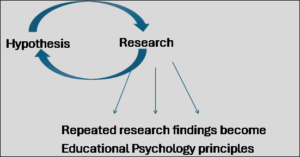Using Research to Guide Teaching Practices

Case Study
Maya listened as her colleagues discussed activities they were doing in their classrooms while they ate lunch together in the teacher’s lounge. She was excited about starting her first year as a fourth-grade teacher. She was also very busy, teaching during the day and attending classes in the evening to complete her master’s degree.
Her colleagues discussed ways they differentiated instruction in their classrooms to support each student’s learning. They mentioned using graphic organizers, giving students choices in learning activities, and pairing and grouping students to work together. Maya was familiar with these concepts from the courses in her teacher preparation program, and she listened carefully to her colleagues’ conversation for ideas that she could implement in her own classroom.
However, she was surprised to hear one of her colleagues describe differentiating instruction by addressing students’ learning styles and whether they are left-brain or right-brain learners. Maya had learned in her educational psychology course that both of those concepts are neuromyths – myths about how students learn based on misconceptions about neuroscience. She had learned that although the belief that students have learning styles may be widespread in education, there is no scientific research to support it. Similarly, she knew students should not be classified as left-brain learners who are better at logical thinking or right-brain learners who are more creative. Maya had learned that the hemispheres of the brain always work together to complete any task. She knew that labeling her students in ways that impose limitations on their skills would limit her expectations of them and affect their own self-concepts as learners.
One of Maya’s goals as a teacher is to remain informed about evidence-based teaching practices using research that is relevant to her students and the subjects she is teaching. She wants to be certain she is making the best use of the instruction time she has available.
Think About It
Are there any teaching practices that you believed were evidence-based but learned they were not during the courses in your teacher education program? Are there any teaching practices you want to investigate to determine if they will be effective strategies for teaching the students and subjects you plan to teach?
Using evidence-based teaching practices helps maximize student learning, so teachers must be aware of whether the instruction methods they use in their classrooms are supported by research. In this chapter we will describe how to find information about research studies that are relevant to your teaching. We will also discuss types of research studies and how you can conduct research in your own classroom.
In educational psychology we rely on evidence from peer-reviewed published research studies to guide our decisions about teaching practices. Research is called peer-reviewed when experts on the research topic have reviewed a report of the research and recommended that the report be published in a scholarly journal. Research studies that are peer-reviewed use scientific methods to test hypotheses systematically. The scientific research process typically involves first identifying a specific research question and a hypothesis, or expected answer, to the question. Then researchers collect and analyze data to answer the research question. Finally, they share the research findings with peers.
Sharing the research findings is an important step in the research process. After a study is published, the findings not only inform teachers about best practices, but they also provide other researchers with ideas for follow-up research studies. As additional research is conducted, researchers gradually build a body of literature about a topic, a collection of published research articles. In time, when multiple studies have similar findings about effective teaching practices, we can be confident we should apply those principles in our classrooms to support student learning (see Figure 1.1).
Figure 1.1

Let’s look at an example of how our understanding of best practices for teaching can develop through a series of research studies. Cooperative learning, where students work in small groups to complete learning tasks, has been used in classrooms for decades (Gillies, 2016)[1]. A series of studies helped build our understanding of how to best use small groups during classroom learning. Those studies include:
- A classic study about cooperative learning, published in 1981, in which a group of researchers found that students learned more when doing cooperative learning activities than when doing the work alone (Johnson, Maruyama, Johnson, Nelson, & Skon, 1981)[2]. The study also found cooperative learning activities improved achievement across subjects and grades.
- Further studies found that there were also social benefits to cooperative learning, including increased self-esteem and positive peer relationships (Johnson & Johnson, 2002[3]; Slavin, 1989[4]).
- Follow-up research by Roseth, Johnson and Johnson (2008)[5] looked at how these social benefits come about and learned that having shared goals helps build peer connections.
- Research by Johnson, Johnson, Roseth and Shin (2014)[6] explored ways teachers can make cooperative learning most effective and identified five factors necessary for successful cooperative learning, including teaching the students active listening skills to improve peer interactions.
As you can see, when one research study finds a way to improve student learning, this can lead to additional studies about related topics. The follow-up studies help educators develop and refine strategies for using the practices in their classrooms.
- Gillies, R. (2016). Cooperative learning: Review of research and practice. Australian Journal of Teacher Education, 41(3), 39-54. ↵
- Johnson, D., Maruyama, G., Johnson, R., Nelson, D., & Skon, L. (1981). Effects of cooperative, competitive, and individualistic goal structures on achievement: A meta-analysis. Psychological Bulletin, 89(1), 47-6. ↵
- Johnson, D., & Johnson, R. (2002). Learning together and alone: Overview and meta-analysis. Asia Pacific Journal of Education, 22(1), 95-105. ↵
- Slavin, R. (1989). Cooperative learning and student achievement. In R. Slavin (Ed.), School and classroom organization (pp. 129-156). Lawrence Erlbaum. ↵
- Roseth, C., Johnson, D., & Johnson, R. (2008). Promoting early adolescents’ achievement and peer relationships: The effects of cooperative, competitive, and individualistic goal structures. Psychological Bulletin, 134(2), 223-246. ↵
- Johnson, D., Johnson, R., Roseth, C., & Shin, T. (2014). The relationship between motivation and achievement in interdependent situations. Journal of Applied Social Psychology. 44(9), 622–633. ↵
Peer-reviewed research has been reviewed by experts in the relevant field to ensure that the research is of a level of quality worthy of publication in scholarly journals.
The body of literature about a research topic is the collection of published peer-reviewed journal articles about the topic.
